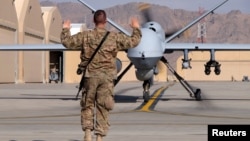U.S. President Barack Obama has approved new authorities for U.S. forces in Afghanistan that loosen restrictions over airstrikes and give U.S. forces more flexibility in how they partner with Afghan troops.
The announcement comes as Afghanistan battles a resurgent Taliban, gains by the al-Qaida-linked Haqqani network and efforts by Islamic State to move in.
"The conditions have changed a lot," said Anthony Cordesman, military analyst and Arleigh A. Burke Chair in Strategy at the Center for Strategic and International Studies.
The president vowed to bring an end to wars in Iraq and Afghanistan when he took office, but nearly eight years later violence, conflict and instability have spread to other countries, such as Syria and Libya.
"I think the whole idea that presidents can make national security promises, regardless of what actually happens, regardless of realities on the ground, is an extraordinarily dangerous idea," said Cordesman, who served as an adviser to the departments of state and defense during the Iraq and Afghan wars. "Presidents can't do that."
Obama approved the new authorities for U.S. troops based on the advice of military commanders and intelligence officials, according to a senior administration official.
U.S. forces can "more proactively support Afghan conventional forces" by providing "close air support" and by accompanying them during ground operations, the official said.
Troop numbers
But the decision to widen the U.S. military's role does not alter the Obama administration's mission or plan to reduce troop levels in Afghanistan, said White House spokesman Josh Earnest.
"I would encourage you not to try to interpret anything about a future potential decision on troop numbers with the new authorities," he said.
The Obama administration's current plan is to reduce the number of U.S. troops from the current 9,800 to around 5,500 by the end of the year.
The U.S. mission still centers on two goals, officials said: combating terrorism and training, advising and assisting Afghan security forces.
Obama declared an end to the U.S. combat mission in Afghanistan in 2014, and Earnest argued that U.S. troops will not engage in combat now.
"This authority would allow U.S. forces to accompany conventional Afghan forces in certain situations," the spokesman said. "But when they are accompanying them, they continue to remain focused on the advise-and-assist mission that they have been carrying out now for almost two years."
Afghan forces
Cordesman said Afghan security forces had not received enough training and resources to take the lead role in securing their own country when the U.S. combat mission came to an end.
"They weren't ready when U.S. combat forces withdrew at the end of 2014," Cordesman said. "And the president has reacted but he has reacted in ways that seem to do the most he can to fulfill the promise of reducing U.S. forces."
The current U.S. plan calls for the 5,500 troops to remain in Afghanistan, at bases including in Bagram, Jalalabad and Kandahar.
But the country's future remains uncertain with no clear indication of how much U.S. and NATO troops will remain involved in the conflict.
And despite costly U.S. reconstruction efforts, Afghanistan remains impoverished, steeped in corruption and desperately in need of development.
"You're passing on to the next president a very, very uncertain U.S. level of action and commitment," Cordesman added. "You don't have a clear strategy and the situation is likely to be worse at the time that the president leaves office than it is now."










